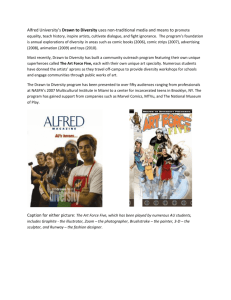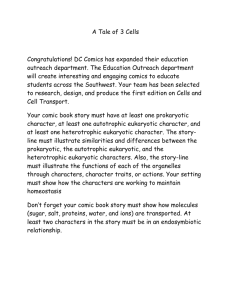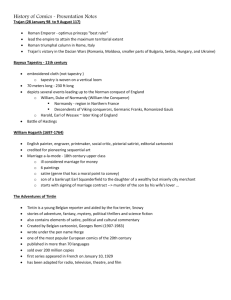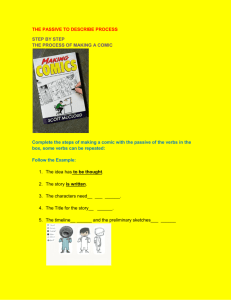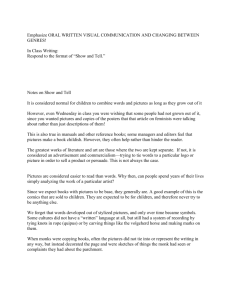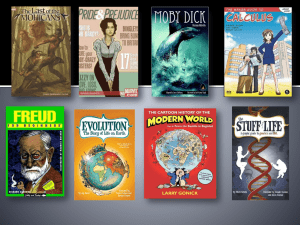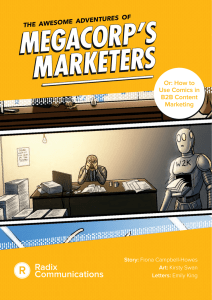The Comic Book Code
advertisement
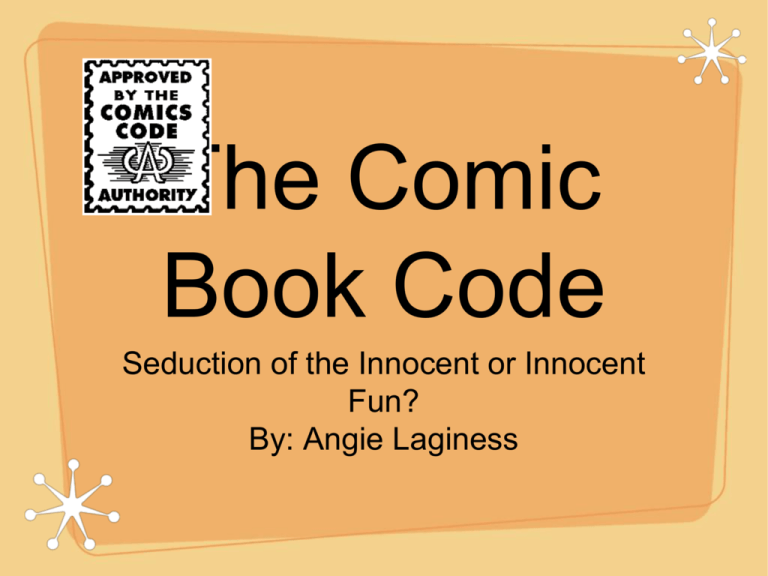
The Comic Book Code Seduction of the Innocent or Innocent Fun? By: Angie Laginess Assumptions Take a minute and write down one complaint either you or someone else may have about comic books What do you think one of the biggest complaints could be? According to some People, Comic Books Are: Too violent Not for a child audience Creates juvenile delinquents Give readers “bad ideas” Too sexual Mindless”junk” Fantasy • These are just a few of the reasons why the Comic Book Code came into effect Frederic Wertham • Was the chief crusader against comic books starting in the 1940’s and is often cited as the reason for the “downfall” of comics • Thought that comic books made juvenile delinquents out of its readers • He wrote the book Seduction of the Innocent (1954) which explored the effects of mass media violence on children (Nyberg 50) • It became such a hit with parents everywhere that articles started popping up in magazines like Ladies Home Journal • Articles entitled “What Parents Don’t know about Comic Books” and “The Effects of Comic Books on Children” frightened adults to take action- which was exactly what Wertham wanted Other thoughtsWertham wasn’t alone • • Sterling North was cited as saying, “Badly drawn, badly written, and badly printed-a strain on the young eyes and young nervous systems-the effects of these pulp-paper nightmares is that of a violent stimulant. Their crude blacks and reds spoils a child’s natural sense of colour; their hypodermic injection of sex and murder make the child impatient with better, though quieter, stories. Unless we want a coming generation even more ferocious than the present one, parents and teachers throughout America must band together to break the ‘comic’ magazine” (Coville 1) Here we see North’s personal biases projected as fact onto the genre (badly writeen, etc.), we see his objection to things as simple as the surface features (in my opinion this serves to make sure adults can have the “ah-hah” moment and witness the same“problems” Wertham discusses with their own eyes), his instilling of paranoia , and a call to arms for all adults who “care about the future” to take action and stop the comic book industry from continuing their corruption of the innocent Censorship • Wertham’s book sparked such a nation-wide fear of the hidden dangers of comic books that terrible things for the industry started happening • Schools, stores, libraries, and many other social institutions began banning the books • City-wide book burnings started happening • Rules and regulations were put into place to ensure that unsuitable material for children would no longer be put into these magazines Book burnings sprung up all over the country as angry mobs went house to house searching for more fuel for their fire Paranoia • The fear of comics was a “fear from within”- we weren’t getting these books from foreign countries, we were giving them to our own children (Hajdu 112) • During this time there was already a terrible frenzy over UFO sightings and the communist scare (Joseph McCarthy was currently at congress railing against what he thought was secret communists in the government) (Hajdu 209) • Put them all together and you have the perfect recipe for a nation-wide witch-hunt • In 1948 some of the popular comic book publishers formed the Association of Comic Magazine Publishers (ACMP) to create guidelines that future comic books had to meet in order to gain the “seal of approval” • They formed the committee in order to reduce the amount of scrutiny they found themselves under • In 1950 even the US federal government became involved in the publishing of comics and a special committee of the US senate was formed • Comics became a serious topic of discussion everywhere The Comics Code of 1948 • The Association of Comics Magazine Publishers, realizing its responsibility to the millions of readers of comics magazines and to the public generally, urges its members and others to publish comics magazines containing only good, wholesome entertainment or education, and in no event include in any magazine comics that may in any way lower the moral standards of those who read them. In particular: • • • • • • • 1. Sexy, wanton comics should not be published. No drawing should show a female indecently or unduly exposed, and in no event more nude than in a bathing suit commonly worn in the United States of America. 2. Crime should not be presented in such a way as to throw sympathy against the law and justice or to inspire others with the desire for imitation. No comics shall show the details and methods of a crime committed by a youth. Policemen, judges, Government officials, and respected institutions should not be portrayed as stupid, ineffective, or represented in such a way to weaken respect for established authority. 3. No scenes of sadistic torture should be shown. 4. Vulgar and obscene language should never be used. Slang should be kept to a minimum and used only when essential to the story. 5. Divorce should not be treated humorously or represented as glamorous or alluring. 6. Ridicule or attack on any religious or racial group is never permissible. 1954 Comic Book Code • See handout… Some of Wertham’s and others’ Complaints • Too many men were drawn in “homosexual” ways, for example he thought that Batman and Robin were “gay”- they stood with their legs open far too much • The depictions in comics were low-brow and had no sophistication or virtues to them (Hadju 210) • Take a minute to look at your comic handout. What are some of the codes that it breaks? • Insert Picture • Insert Picture Comic books have come far over the past years • No longer depicting only crime and horror (as the naysayers have argued) comics have expanded to text books and historical nonfiction • According to Scott McCloud, comics have unlimited potential. They “command viewer involvement and identification” and have the ability to “capture the beauty and complexity of the visible world” (McCloud 204) • Censorship has historically been a means for people in authority to disempower those “below” themselves. Afraid of the tremendous power comics held within their pages, adults took action. Unfortunately, that action created the Comic Book Code, and some say the industry has never recovered from that fatal blow • But as time goes on and visual media continues to grow, I think people will begin to see just how amazing comics can be So What? • The Comic Book Code has never truly been abolished and as long as people continue to see comics as “base, immoral trash” the negative stigma carried with the name will never end • As Scott McCloud has pointed out, pictures have pre-dated nearly every form of communication out there. As children we are given pictures as our first means of learning and participation in life, and comics give readers one more way of viewing the world in which they live • If comic books have the power to get children and young adults interested in reading, we should allow them to look at both pictures and words together without considering the readers to be unintelligent or lacking in sophistication • Works Cited and Consulted for The Comics Code • Coville, Jamie. "Seduction of the Innocents and the Attack on Comic Books: The Comic Book Villain, Dr. Fredric Wertham, M.D." Integrative arts 110. 1 Mar. 2007. Pennsylvania State University. <http://www.psu.edu/dept/inart10_110/>. • Goldwater, John. Americana in Four Colors: A Decade of Self Regulation by the Comics Magazine Industry. Jackson:: Comics Magazine Association of America, 1964. • Bender, Pennee. "Good Shall Triumph over Evil: The Comic Book Code of 1954." History Matters: The U.S. Survey Course of the Web. 31 Mar. 2006. The American Social History Project / Center for Media and Learning. 5 May 2009 <http://historymatters.gmu.edu/>. • Hajdu, David. The Ten-Cent Plague: The Great Comic-Book Scare and how it Changed America. New York: Picador, 2008. • Mccloud, Scott. Understanding Comics: The Invisible Art. New York: Harper Paperbacks, 1994. • Nyberg, Amy Kiste. Seal of Approval: The History of the Comics Code. Jackson: University Press of Mississippi, 1998. • Weiner, Stephen. Faster than a Speeding Bullet: The Rise of the Graphic Novel. New York: Nantier, Beall, and Minoustchine Publishing Inc., 2003.
